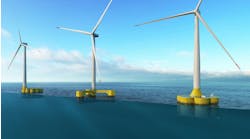X1 Wind ready for PivotBuoy installation after dynamic cable deployment
Offshore staff
BARCELONA, Spain — Technology developer X1 Wind has successfully laid its dynamic cable and is ready for final installation of its fully functional floating wind PivotBuoy prototype at the PLOCAN Test Site in the Canary Islands.
Having installed the modular concrete gravity anchoring system last spring, the Barcelona-headquartered firm is announcing another significant milestone in its first ocean deployment project after completing the dynamic cable lay.
Adrian Oliva, X1 Wind’s electrical engineering manager, said, “The 20kV dynamic cable will allow us to fully validate the floater and wind turbine performance, feeding the electricity to PLOCAN’s smartgrid, as well as transmitting data through its fiber-optic connection. Also, we will be able to validate the cable’s dynamic behavior. Understanding how our TLP mooring system reduces motions and loads on the cable, compared to catenary systems, is crucial as it will reduce fatigue and potentially extend the lifetime of this critical component."
X1 Wind's X30 platform is fully equipped with all the electrical systems that the company's commercial platforms will incorporate. The Vestas V29 turbine, originally designed for fixed foundations, has been retrofitted using a full-converter supplied by ABB, and the control has been optimized to floating conditions. The voltage is increased to 20 kV with a transformer to allow the connection to PLOCAN’s smartgrid with the 1.4-km-long dynamic cable. The dynamic cable will be connected to X1 Wind's platform using a connector supplied by Ditrel. All components have successfully been tested at port, and the prototype is now ready to be installed in the next suitable weather window. Once installed, X1 Wind will be monitoring the platform in real time with multiple sensors integrated in the company's in-house SCADA system.
With the trade-winds blowing strong in the Canary Islands until mid-September, X1 Wind’s team will wait for a suitable weather window to complete the towing and hookup of the PivotBuoy prototype.
PivotBuoy aims to substantially reduce the current levelized cost of electricity (LCOE) of floating wind. Key advantages of the PivotBuoy system include a reduced floater weight, faster and cheaper installation processes, and the ability to reach deeper waters with minimal seabed footprint due to the TLP mooring system.
08.02.2022



